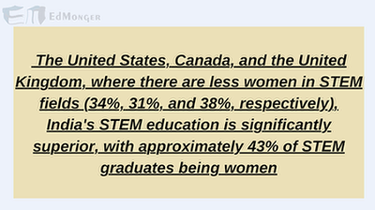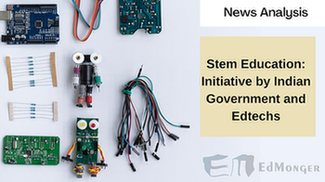Science has played a crucial role in transforming human lives. From uncovering important discoveries to fast-forward development, it helps humans achieve significant advances in many areas via digitalization. And after arriving at a technical revolution, the need for advancement in education arises, which makes it crucial for countries to cultivate a pool of highly trained and educated workers. Then the term arrived for STEM education, comprising science, technology, engineering, and mathematics.
STEM education is now the backbone of every economy and has the potential to avert any potential crisis. Every socioeconomic group of learners has learned practical concepts from STEM education. Elementary and secondary school students benefit from STEM education by gaining access to information and ways of thinking applicable to solving issues in the real world.
If you are unfamiliar with the term” STEM learning” and assume that it refers solely to a technique of instruction in the technical fields, you would be wrong. It’s creative and helps students develop an entrepreneurial mindset.
STEM Education: The World And India
Today, education is in dire need of new approaches and innovations. Many organizations and individuals in India are working to increase interest in STEM fields, and the Government of India is also actively supporting this effort. However, it is challenging to make significant progress in each business without being innovative.
Unfortunately, India needs to catch up to other countries regarding educational technology innovation. Nowadays, everyone prefers to rely on pre-existing tools and software rather than develop their own. And it is being said that consumers in India have historically served as users rather than creators.
This trend can also be reversed if we invest more in STEM education. Just look at the data:
India is one of the largest STEM job marketplaces in the world and produces 31.7% of all STEM graduates worldwide.
As per https://www.thequint.com

No matter where you live, K-12 children can benefit from STEM education, even those in rural areas. A completely focused approach to STEM subjects in school can help the students to alter their ideas in the form of a unified invention and nurture their ability to think, act, and to solve problems.
A separate organization for STEM education in other countries is responsible for formulating rules for these subjects. In the same manner, India has the STEM India Foundation, which provides educators with resources. This encourages them to help the students to pursue research, development, and creation throughout the STEM fields.
What Is The Scope Of STEM Education In India?
As the current wave of technological advancements in India continues to spread, it is clear that the country is making great strides in every sector. Similarly, this is true in the domain of education. Technology is needed in every field; in the same way, STEM education is also required in edtech.
India’s sciences, technologies, engineering, and mathematics education have much-untapped potential. The National Education Policy calls for an educational system that challenges students” thinking and provides them with ample room to experiment with new ideas. Also, STEM is the next big thing in educational technology after the technological revolution.
And to help the students in STEM, including computer science, engineering, artificial intelligence, and robotics, the Government, edtech firms, and Niti Aayog joined hands and established Atal Tinkering Labs (ATL)
How do the Indian Government And Edtech help promote STEM Education In India?
The Indian Government has given its full support to STEM education. If we talk about the beginning of this year, the Government launched a national portal called I-STEM. It is a national platform that serves as a hub for various STEM-related initiatives.
The program was launched as a part of the Government’s “Swayam” initiative, which aims to direct skill-building and module-development efforts at educational institutions using various technology tools. This portal will aid in setting up an atmosphere where R&D will be fostered, and numerous projects will be observed in the upcoming years.
Let’s check out some of the initiatives taken by the Government.
Atal Tinkering Labs (ATL)
As part of its mission to strengthen the education system, NITI Aayog has worked to serve students with a mindset of practical learning. It is aimed at kids in India from kindergarten through high school and provides them with a space to explore, discover, and form their thoughts about the many fascinating fields that make up modern science.
To encourage students to put what they have learned into practice, these programs set up environments where they may work on projects similar to do-it-yourself projects.
As a result, the Inborn passion for STEM (Science, Technology, Engineering, and Math) will be enhanced. Besides, when students study a subject via practical application, they will not only acquire a stronger connection to that subject but also have a profound understanding of every concept.
The skillsets of today’s youth—creativity, inventiveness, critical thinking, etc.—are being fostered by ATLs and are in high demand.
I-STEM Initiative
Prime Minister Narendra Modi unveiled I-STEM, a national gateway for science, technology, engineering, and mathematics, in January 2022. The Government of India’s Principal Scientific Adviser Office is the driving force behind this initiative.
This evolving hub is meant to inspire and sustain the work of scientists and researchers while also contributing to the growth of the R&D community. This is planned to integrate the most famous Modi government’s” Atma Nirbhar Bhara” program.
This initiative aims to encourage women who have studied STEM fields to participate in the development of new technologies. Along with this, they also target the students by providing them the space (especially women) who are interested in these fields and feel comfortable asking questions and sharing their ideas.
In the not-too-distant future, it is anticipated that there will be a minimum of thirty percent (30.0%) of female representation in decision-making bodies in the region, including evaluation and selection committees.
Women can participate in the WEST program to become stakeholders and advance their careers in research and development (R&D) at various levels, such as technicians, technologists, scientists, and business owners.
Robo Shiksha Kendra
Robo Shiksha Kendra is an extraordinary corporate social responsibility venture conceived by the STEM India Foundation to cultivate young minds to become future innovators.
Under this scheme, students will be given exposure to robotics. Students will get a chance to showcase their proficiency on robotics platforms. This helps kids develop a scientific mindset with utmost creativity. The NCERT National Framework Curriculum is adhered to in implementing this strategy.
This scheme emphasizes inclusivity while maintaining cheap costs per individual student. And if any student wants to compete internationally, then mentorship will be provided to participate in the contest.
Thoughts
Finally, we want to assure parents concerned about their children’s ability to succeed in a STEM-focused education that they need not worry. A bit of thought and research into the resources that facilitate the child’s understanding of the topic via gamification is all needed. Lastly, we want to stress the importance of not forcing a student to study; the more straightforward the information is presented, the faster the student will grasp its meaning.
By Pragati Sharma




